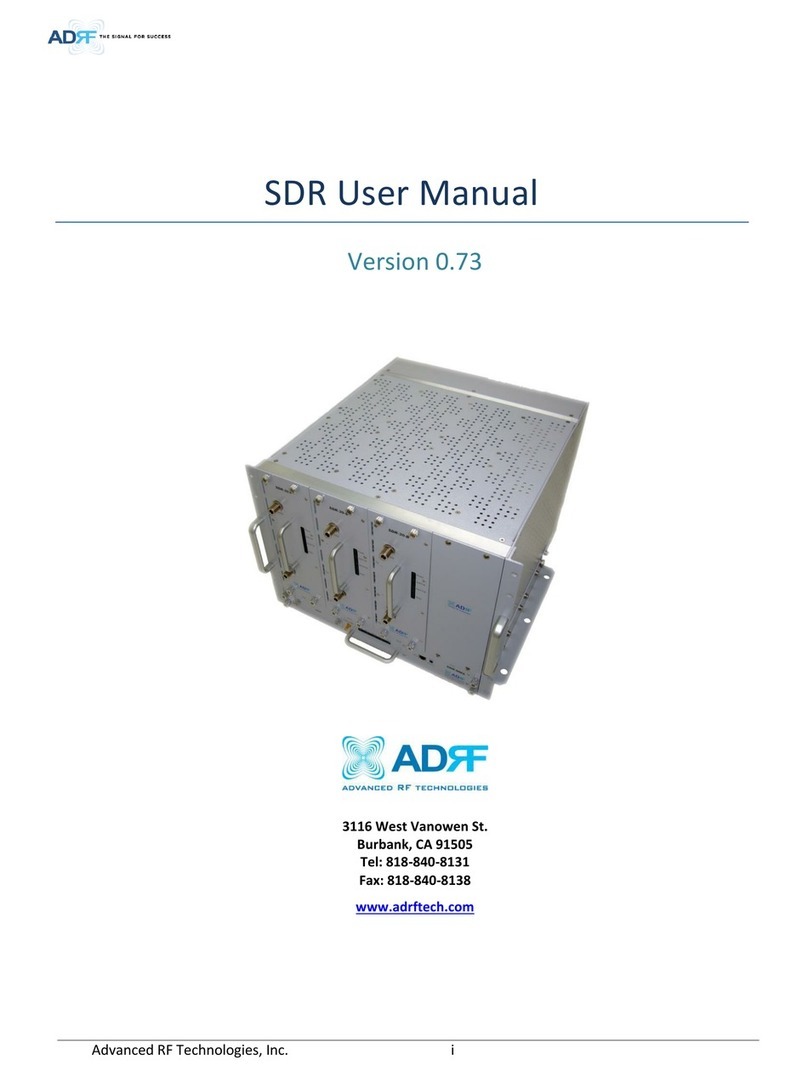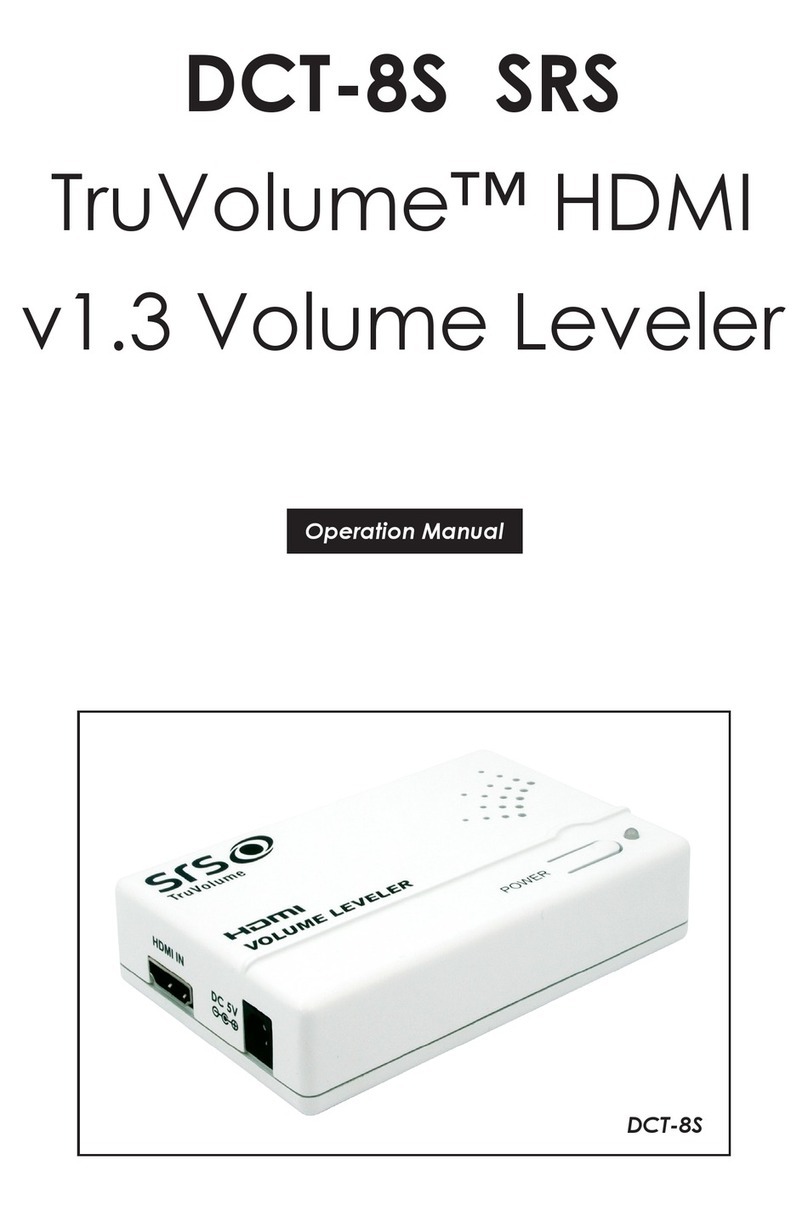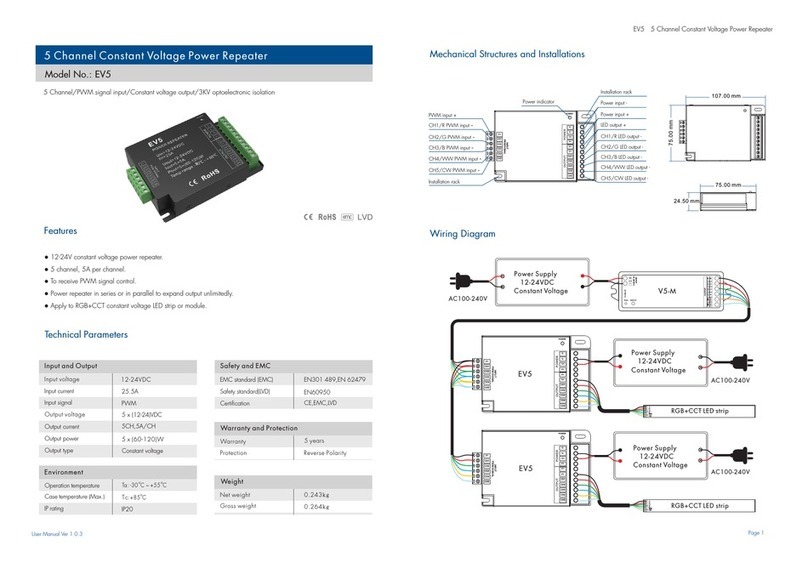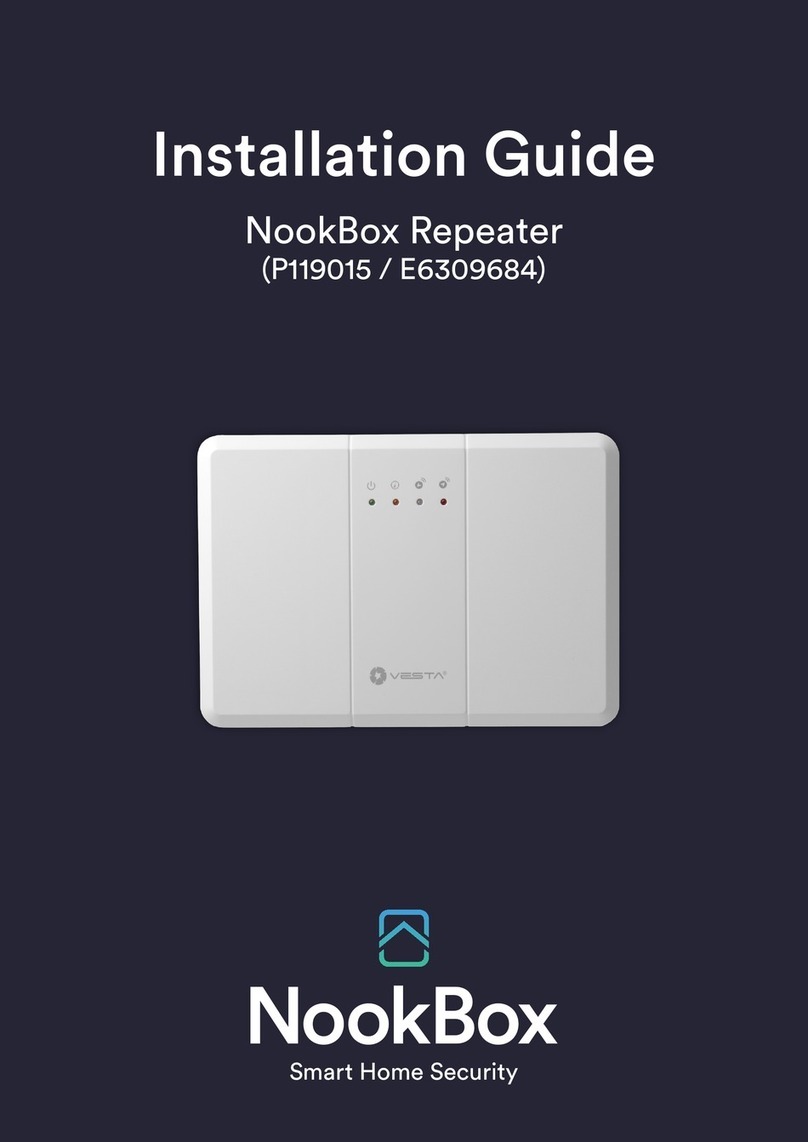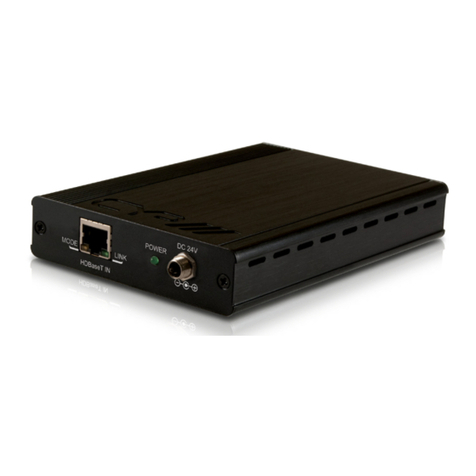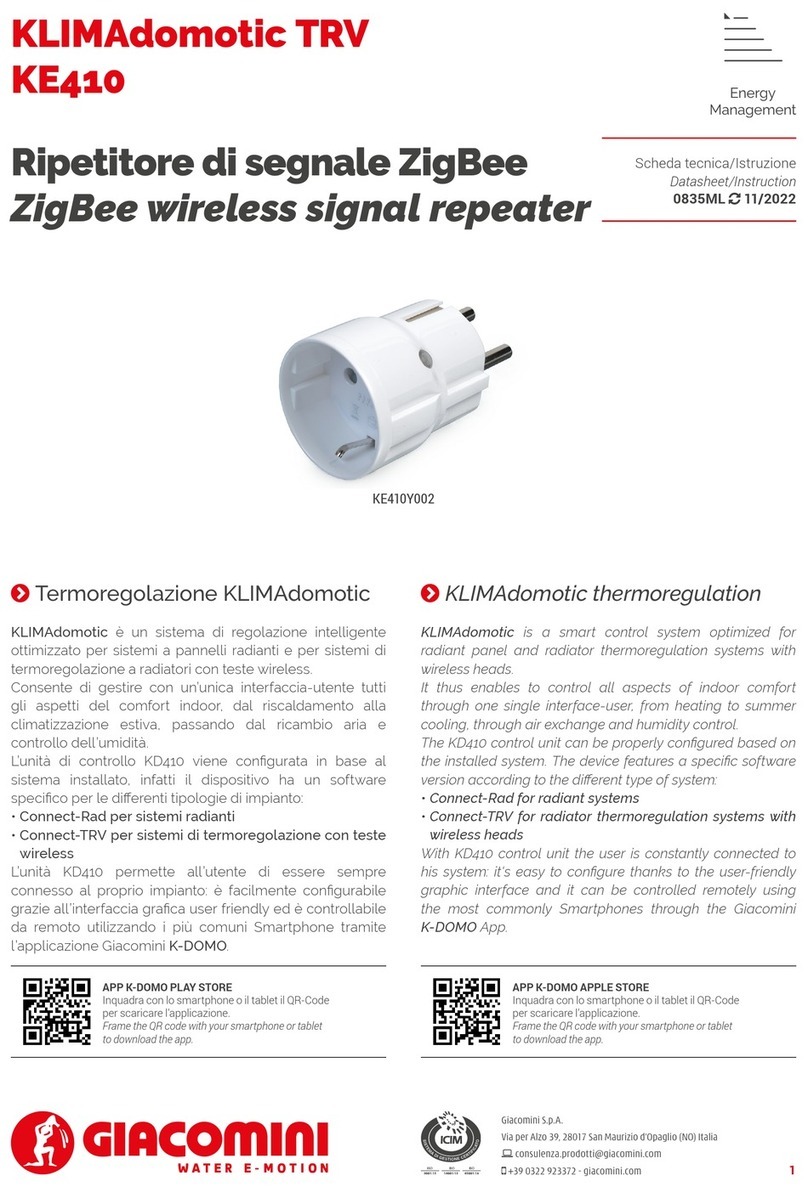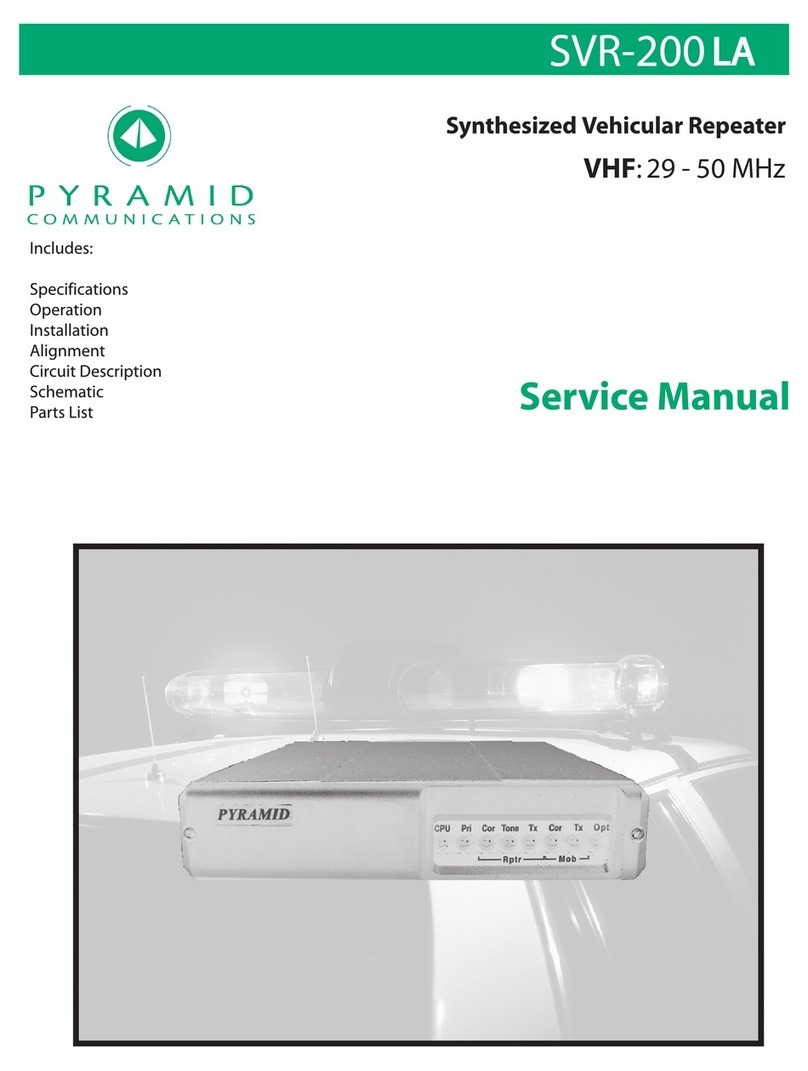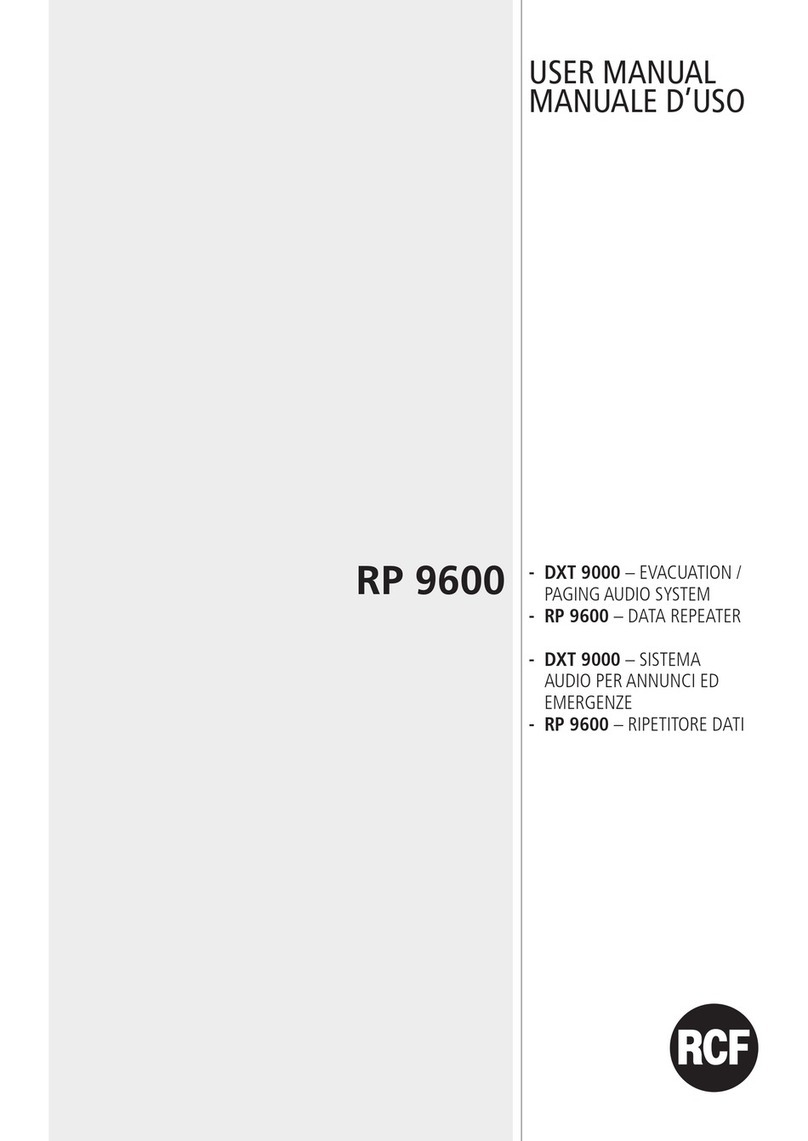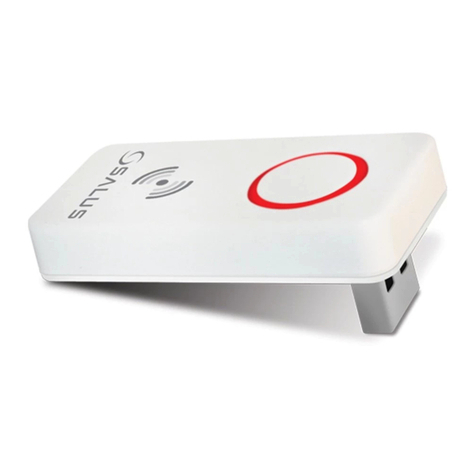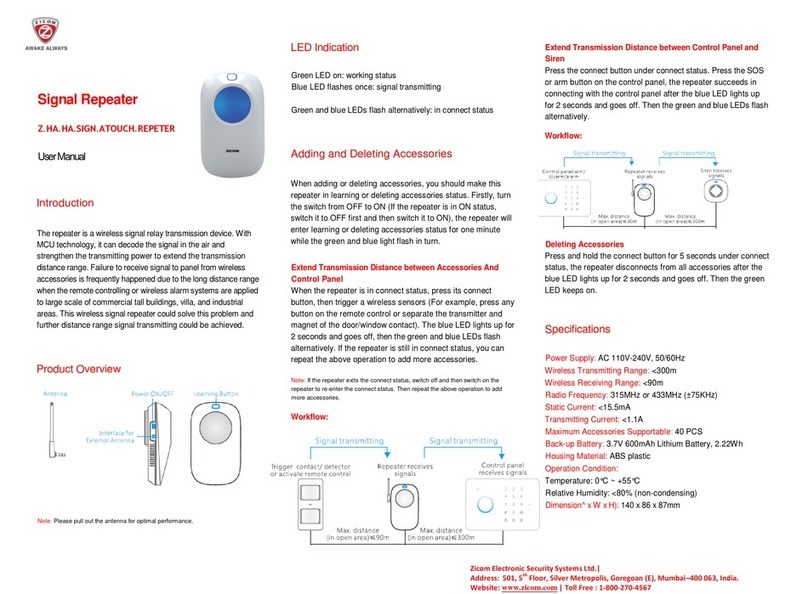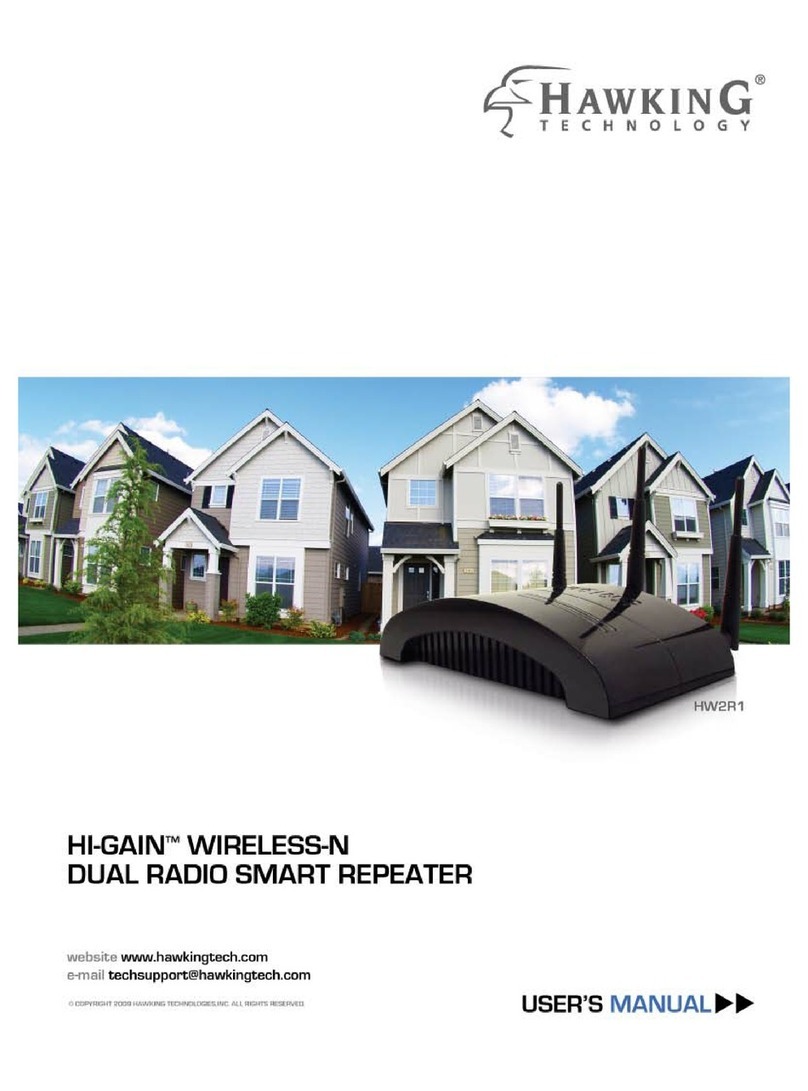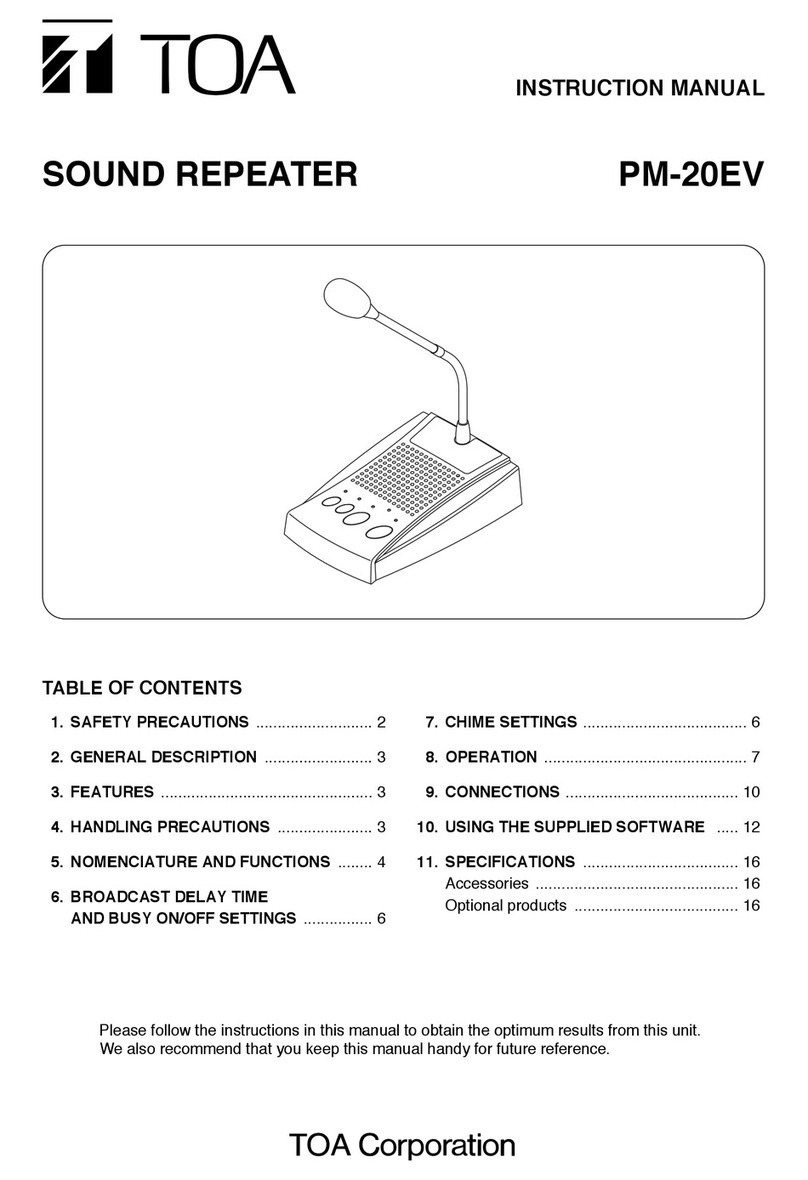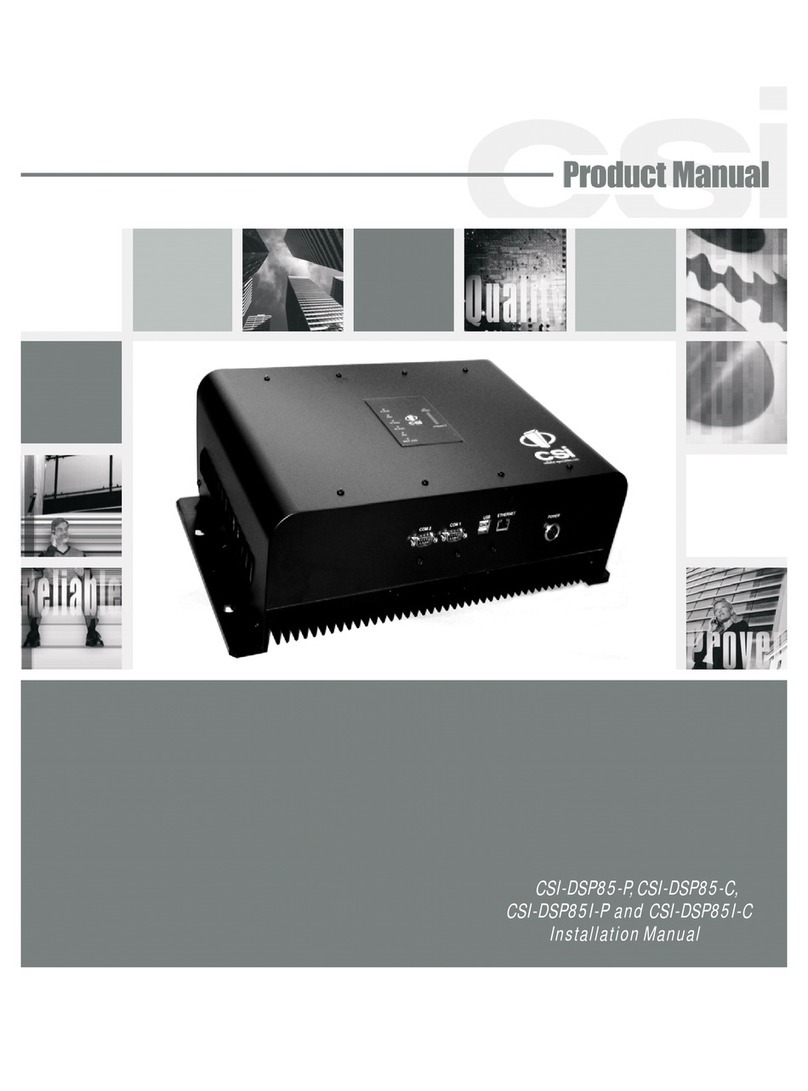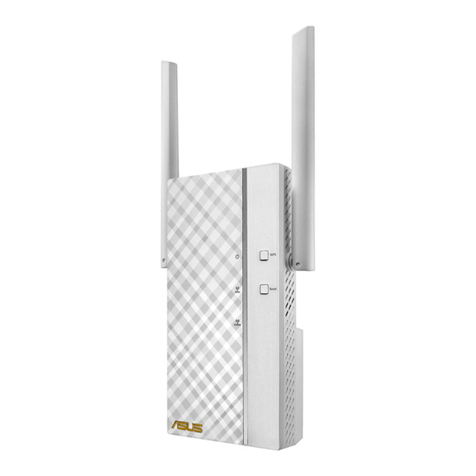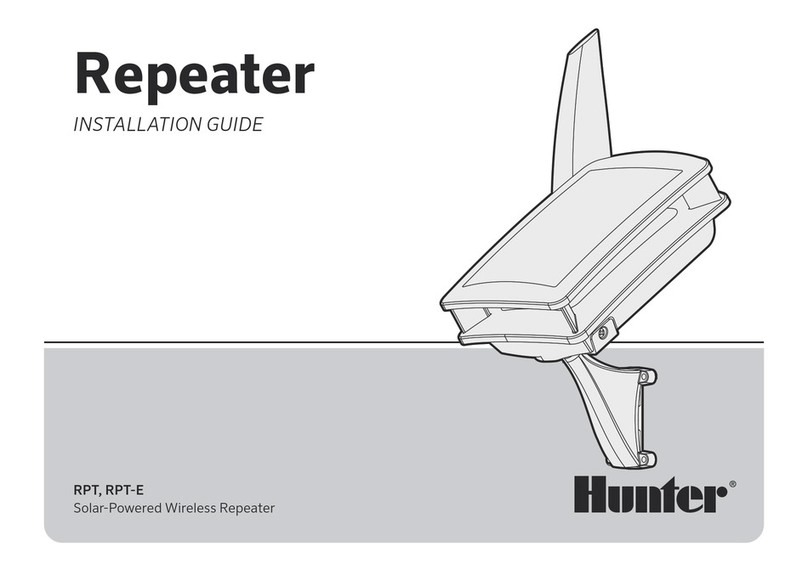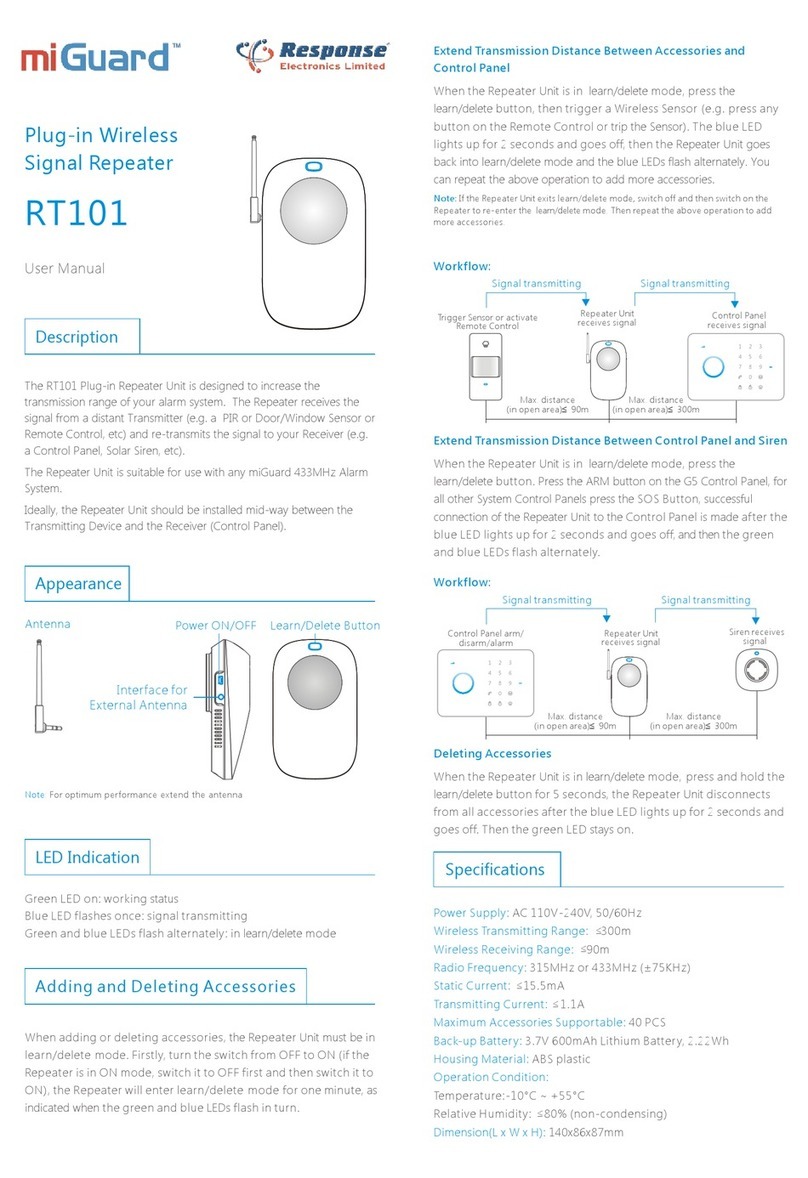ADRF Duo-i6525 User manual

Duo-i6525
USER MANUAL
Version 1.0
2607 Colorado Blvd.
Los Angeles, CA 90041
USA
Tel: 323-254-8131
Fax: 323-254-4928
www.adrftech.com

Duo-i6525 RF Repeater
User Manual V1.0
Glossary
The following is a list of abbreviations and terms used throughout this
document.
Abbreviation/Term Definition
AGC Automatic Gain Control
ALC Automatic Level Control
AROMS ADRF’ Repeater Operation and Management
System
BTS Base Transceiver Station
CDMA Code Division Multiple Access
CFE Compact Front End
CW Continuous Wave (un-modulated signal)
DAS Distributed Antenna System
DL Downlink
Downlink The path covered from the Base Transceiver
Station (BTS) to the subscribers service area
via the repeater
HPA High Power Amplifier
HW Hardware
iDEN Integrated Digital Enhanced Network
IF Intermediate Frequency
LNA Low Noise Amplifier
MS Mobile Station
PLL Phased Locked Loop
PS Power Supply
RF Radio Frequency
SQE Signal Quality Estimate
SW Software
UL Uplink
Uplink The path covered from the subscribers service
area to the Base Transceiver Station(BTS) via
the repeater
VSWR Voltage Standing Wave Ratio
Advanced RF Technologies, Inc. Proprietary Document Page 2 of 31

Duo-i6525 RF Repeater
User Manual V1.0
Version 1.0 (Released January 08, 2007)
Information in this document is subject to change without notice.
Advanced RF Technologies, Inc. 1996-2007.
All rights reserved.
Please send comments to:
E-Mail: [email protected]
Phone: (323) 254-8131
Fax: (323) 254-4928
Address: Advanced RF Technologies, Inc.
Attention: Technical Publications Department
2607 Colorado Blvd., 1st Floor
Los Angeles, CA 90041
USA
www.adrftech.com
Advanced RF Technologies, Inc. Proprietary Document Page 3 of 31

Duo-i6525 RF Repeater
User Manual V1.0
TABLE OF CONTENTS
1. Duo-i6525 .........................................................................................................5
1.1. Introduction.....................................................................................................5
1.1.1. Highlights ......................................................................................5
1.1.2. Parts List ........................................................................................5
1.1.3. Repeater Quick View.......................................................................7
1.2. Warnings and Hazards........................................................................................8
2. Duo-i6525 Overview ..........................................................................................9
2.1. Block Diagram.................................................................................................9
2.2. Operation Modes ............................................................................................10
2.2.1. Local Web GUI ..............................................................................10
2.2.2. Remote NMS (Modem Option) .......................................................10
2.3. Components ..................................................................................................10
2.3.1. 2.3.1 Power Supply.......................................................................10
2.3.2. Controller.....................................................................................10
2.3.3. Down Converter Module ...............................................................10
2.3.4. Up Converter Module....................................................................10
2.3.5. Quad-Plexer.................................................................................11
2.3.6. Digital Filter .................................................................................11
2.4. Switches & Indicators ......................................................................................12
2.4.1. LEDs.............................................................................................12
2.4.2. Power Switch ................................................................................13
2.4.3. Mode Selection Switch ..................................................................13
2.5. Installation....................................................................................................14
2.5.1. Tools............................................................................................14
2.5.2. Procedure.....................................................................................14
2.5.3. Grounding ....................................................................................16
2.5.4. Antenna Separation/Isolation........................................................17
3. Duo-i6525 AROMS Setup .................................................................................19
4. Maintenance Guide for Duo-i6525....................................................................26
4.1. Periodic Inspection Checklist .............................................................................26
4.2. Preventive Measures for Optimal Operation ...........................................................26
4.2.1. Recommendations ........................................................................26
4.2.2. Precautions ..................................................................................27
5. Warranty and Repair Policy ...............................................................................27
5.1. General Warranty............................................................................................27
5.2. Limitations of Warranty....................................................................................27
5.3. Limitation of Damages.....................................................................................27
5.4. No Consequential Damages ...............................................................................27
5.5. Additional Limitation on Warranty ......................................................................27
5.6. Return Material Authorization (RMA) ..................................................................28
Appendix A: Specifications ................................................................................................29
Advanced RF Technologies, Inc. Proprietary Document Page 4 of 31

Duo-i6525 RF Repeater
User Manual V1.0
1. Duo-i6525
1.1. Introduction
Duo-i6525 is a dual band SMR (800 and 900 MHz) RF repeater which enhances
in-building wireless coverage in the most effective and cost efficient way. For its
intelligent design and versatility, the Duo-i6525 is the ideal choice for wireless
coverage problems indoors. Duo-i6525 can be used as a stand-alone repeater with
passive antennas connected to it or it can also be used as a feeder repeater to a
DAS (Distributed Antenna System).
1.1.1. Highlights
• Dual Band Repeater (800 & 900 MHz)
• 25 dBm Composite Output Power
• 65 dB gain
• 25 dB AGC Range @ 0.5 dB Step
• Digital Filtering
• Excellent out of band rejection characteristics with Sharp Roll-Offs
@ 65 dBc
• Re-Banding Capability via Digital Filtering
• Band Adjustable Option @ 200 KHz step
• Web GUI Software via DHCP
• Oscillation Detection Scheme
1.1.2. Parts List
Label Qty Description
A 1 iDEN Repeater
B 1 AC Power Cable
C 1 Ground Cable
D 1 Ethernet Cable (Twisted)
E 4 guard screws
F 1 CD
Table 1 – Parts List
Advanced RF Technologies, Inc. Proprietary Document Page 5 of 31

Duo-i6525 RF Repeater
User Manual V1.0
Figure 1 – Duo-i6525 Repeater Parts List
** CD includes: (1) Duo-i6525 User Manual & (2) Duo-i6525 Quick Start Guide
Advanced RF Technologies, Inc. Proprietary Document Page 6 of 31

Duo-i6525 RF Repeater
User Manual V1.0
1.1.3. Repeater Quick View
Power LED
(
Pa
g
e 12
)
Upper Guard
Screw
(
Pa
g
e 14
)
NMS Modem
(
Pa
g
e 10
)
Guard screw
Hole
(
Pa
g
e 14
)
Power Switch
(
Pa
g
e 13
)
Mode Selection
Switch
(
Pa
g
e 13
)
Donor Antenna
Port
(
Pa
g
e 17
)
Server Antenna
Port
(
Pa
g
e 17
)
Wall Mounting
Bracket (Page 14)
Soft Fail LED
(
Pa
g
e 12
)
Hard Fail LED
(
Pa
g
e12
)
Bracket
S
crew
(
Pa
g
e
Ground Hole
(
Pa
g
e 16
)
Lower Guard
Screw
(
Pa
g
e 14
)
Ethernet Port
(
Pa
g
e 19
)
Advanced RF Technologies, Inc. Proprietary Document Page 7 of 31

Duo-i6525 RF Repeater
User Manual V1.0
1.2. Warnings and Hazards
Opening the Duo-i6525 could result in electric shock and may
cause severe injury.
WARNING! ELECTRIC SHOCK
Working with the repeater while in operation, may expose the
technician to RF electromagnetic fields that exceed FCC rules for
human exposure. Visit the FCC website at www.fcc.gov/oet/rfsafety
to learn more about the effects of exposure to RF electromagnetic
fields.
WARNING! EXPOSURE TO RF
Operating the Duo-i6525 with antennas in very close proximity
facing each other could lead to severe damage to the repeater.
WARNING! DAMAGE TO REPEATER
Actual separation distance is determined upon gain of antenna used.
Please maintain a minimum safe distance of at least 20 cm while operating near the
donor and the server antennas. Also, the donor antenna needs to be mounted
outdoors on a permanent structure.
RF EXPOSURE & ANTENNA PLACEMENT Guidelines
Advanced RF Technologies, Inc. Proprietary Document Page 8 of 31

Duo-i6525 RF Repeater
User Manual V1.0
Opening or tampering the Duo-i6525 will void all warranties.
WARRANTY
2. Duo-i6525 Overview
2.1. Block Diagram
Figure 2 – Duo-i6525 Repeater Block Diagram
Advanced RF Technologies, Inc. Proprietary Document Page 9 of 31

Duo-i6525 RF Repeater
User Manual V1.0
2.2. Operation Modes
2.2.1. Local Web GUI
Simply connect one end of the ethernet cable on the repeater monitor port and
the other end on the PC’s LAN port. After doing so, launch the Microsoft
Internet Browser (Internet Explorer) and the Local Web GUI will be launched
through typing the IP address (http://192.168.63.1/home.asp)
2.2.2. Remote NMS (Modem Option)
A CDMA wireless modem can be integrated within a Duo-i6525 repeater.
With this wireless modem, the user can remotely log into the repeater for
monitoring purposes.
2.3. Components
2.3.1. 2.3.1 Power Supply
It provides DC power to each module within the repeater.
2.3.2. Controller
It is responsible for monitoring the status of each module and controls its
parameters. If a CDMA wireless modem is integrated within the repeater, it
also handles the remote “Command & Control” feature as well.
2.3.3. Down Converter Module
The downlink RF signal entered through the cavity filter is converted to IF
frequency, which is later converted back to RF frequency again through digital
filtering. The downlink HPA (high power amplifier) is integrated with the
Down Converter Module.
2.3.4. Up Converter Module
The uplink RF signal entered through the cavity filter is converted to IF
frequency, which is later converted back to RF frequency again through digital
filtering. The uplink HPA (high power amplifier) is integrated with the Up
Converter Module.
Advanced RF Technologies, Inc. Proprietary Document Page 10 of 31

Duo-i6525 RF Repeater
User Manual V1.0
Interface Board
Quad-Plexer
Power Supply
Digital Filter
Digital Filter
Quad-Plexer
Down Converter
Up Converter
Controller
Noise Filter
DHCP
Sub Board
Figure 3 – Duo-i6525 Repeater Internal Components Diagram
2.3.5. Quad-Plexer
It consists of four BPFs (band-pass filters) each of the four RF signal paths:
SMR 800 (Tx & Rx) and SMR 900 (Tx & Rx)
2.3.6. Digital Filter
It is composed of A/D (analog to digital) and D/A(digital to analog) converters.
It also has a FPGA (field programmable gate array) which has the capability
for superior out-of- band rejection and re-banding.
Advanced RF Technologies, Inc. Proprietary Document Page 11 of 31

Duo-i6525 RF Repeater
User Manual V1.0
2.4. Switches & Indicators
2.4.1. LEDs
Duo-i6525 has three LEDs on the top panel of the repeater as show below in
Figure 4.
Figure 4 – Duo-i6525 Repeater LED View
POWER
If the LED is lit GREEN, it indicates that there isAC power to the repeater.
SOFT FAIL
If the LED is lit YELLOW, it indicates that there is a soft fail alarm in the
system. The detailed alarm information can be viewed via the local web GUI.
In the event of a soft fail alarm, the repeater will still function, but the alarm
needs to be addressed promptly.
HARD FAIL
If the LED is lit RED, it indicates that there is a hard fail alarm in the system.
The detailed alarm information can be viewed via the local web GUI. In the
event of a hard fail alarm, the repeater will not function and immediate
attention is required.
Advanced RF Technologies, Inc. Proprietary Document Page 12 of 31

Duo-i6525 RF Repeater
User Manual V1.0
2.4.2. Power Switch
The AC Power on/off switch is located on the bottom of repeater. The switch
should be powered on after the repeater has been installed properly.
2.4.3. Mode Selection Switch
The Ethernet port and the mode selection switch for DHCP are located on
bottom of the repeater as shown below in Figure 5. The mode selection switch
has two modes: Host Mode & Remote Mode.
Figure 5 – Duo-i6525 Repeater Power Switch View
Figure 6 – DHCP & Mode Selection Switch View
Advanced RF Technologies, Inc. Proprietary Document Page 13 of 31

Duo-i6525 RF Repeater
User Manual V1.0
Host Mode
This mode should be selected only if a Duo-i6525 is used alone without being
connected to a collocated Sprint Nextel CDMA repeater functioning as a host.
Remote Mode
This mode should be selected if a Sprint Nextel CDMA repeater is being
installed along with aDuo-i6525 and the ethernet port is being used for
communicating with the CDMA repeater. In this case, a Duo-i6525 works as a
remote sending its information to the collocated Host CDMA repeater.
2.5. Installation
2.5.1. Tools
No special tools or equipments are needed in installing the Duo-i6525.
2.5.2. Procedure
Four mounting holes are provided on the wall-mounting bracket to attach it to
the wall. The wall bracket must be securely attached to sufficiently carry the
weight of the Duo-i6525, which is bolted to the wall bracket through four
aligned mounting holes.
The following steps should be followed while mounting the repeater:
Installation Procedure
① Take the Duo-i6525 out of the box
② Detach the mounting bracket from the Duo-i6525 by unscrewing the 8
screws on the bracket. ( 4 on each side)
③ Using the four guard screws, mount the bracket on the wall
④ Make sure the bracket is securely mounted
⑤ Slightly tilt the repeater and mount the repeater onto the wall as shown in
the picture. Hook the upper 2 guard screws first and then slide/push in the
lower 2 guard screws into the place.
⑥ Make sure the repeater is securely placed onto the wall bracket
⑦ Fasten the 8 bracket screws back properly
⑧ Inspect everything is secure
Advanced RF Technologies, Inc. Proprietary Document Page 14 of 31

Duo-i6525 RF Repeater
User Manual V1.0
Figure 7 – Repeater Mounting Instructions
Advanced RF Technologies, Inc. Proprietary Document Page 15 of 31

Duo-i6525 RF Repeater
User Manual V1.0
2.5.3. Grounding
The Duo-i6525 has locks on the side of the enclosure preventing from the door
opening. In addition, a ground cable is also included in the box and should be
connected to repeater.
Figure 8 – Ground Cable Connection
Advanced RF Technologies, Inc. Proprietary Document Page 16 of 31

Duo-i6525 RF Repeater
User Manual V1.0
2.5.4. Antenna Separation/Isolation
Separation between antennas is necessary to prevent oscillation.
Oscillation occurs when the signal entering the system continually reenters,
due to the lack of separation between the donor and server antennas. In
other words, the signal is being fed back into the system. This creates a
constant amplification of the same signal. As a result, the noise level rises
above the signal level.
Figure 9 - RF Repeater Oscillation
To prevent feedback, the donor and server antennas must be separated by
an appropriate distance to provide sufficient isolation. Isolation is attained
by separating antennas a sufficient distance so that the output of one
antenna does not reach the input of the other. This distance is dependent
on the gain of the repeater.
A sufficient isolation value is 13 ~ 15 dB greater than the maximum gain
of the repeater. For example, if the gain of the repeater is 50 dB, then an
isolation of 63 ~ 65 dB or greater is required. In the same manner,
because the Duo-i6525 has a maximum gain of 65 dB, it requires an
isolation of at least 78 ~ 80 dB.
Advanced RF Technologies, Inc. Proprietary Document Page 17 of 31

Duo-i6525 RF Repeater
User Manual V1.0
2.5.5 Line of Sight
The donor antenna which points towards the base station typically has a
narrow beam antenna pattern. As a result, a slight deviation away from
the direction of the BTS can lead to less than optimum results. In addition,
obstacles between the repeater and the BTS may impair the repeater from
obtaining any BTS signal. As a result, the repeater cannot transmit signal
to the coverage area. Therefore, a direct line of sight to the BTS for the
donor antenna is vital to the function of a repeater. For the same reason,
placing the server antenna in direct line of sight of the coverage area is
also necessary.
Figure 10 - Direct Line of Sight to the BTS
Donor
Antenna
BTS
Advanced RF Technologies, Inc. Proprietary Document Page 18 of 31

Duo-i6525 RF Repeater
User Manual V1.0
3. Duo-i6525 AROMS Setup
i) Connect the LAN cable between laptop’s Ethernet port and repeater’ Ethernet
port.
Note: Under Local Area Connection in Network Settings, make sure to select Obtain
an IP address automatically under Internet Protocol (TCP/IP) properties.
Advanced RF Technologies, Inc. Proprietary Document Page 19 of 31

Duo-i6525 RF Repeater
User Manual V1.0
ii) Launch MS Internet Explorer (Version 6.0 or higher)
Note: ADRF’s Web GUI is not compatible with any other web browsers (e.g.
Netscape, FireFox, Mozilla, etc.).
iii) Please type the following IP address on the address bar of MS Internet Explorer:
http://192.168.63.1/home.asp
iv) The following login screen will appear:
If you are not the Super-User, please type in your assigned username & password
which you should have received from the Super-User.
The default username and password for the General User is adrf & adrf,
respectively.
If the username & password is typed in incorrectly, the following screen will
appear:
Advanced RF Technologies, Inc. Proprietary Document Page 20 of 31
Other manuals for Duo-i6525
1
Table of contents
Other ADRF Repeater manuals

ADRF
ADRF Duo-i6515NM User manual
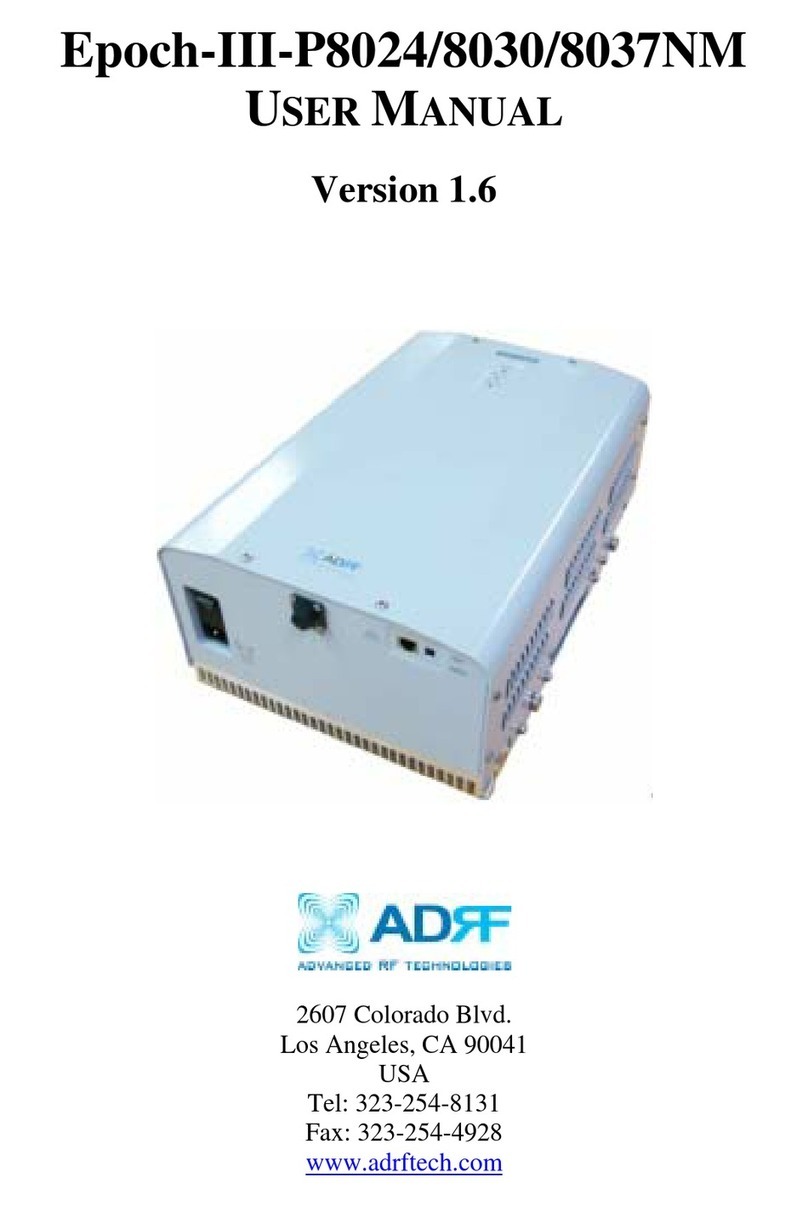
ADRF
ADRF Epoch-III-P8024 User manual
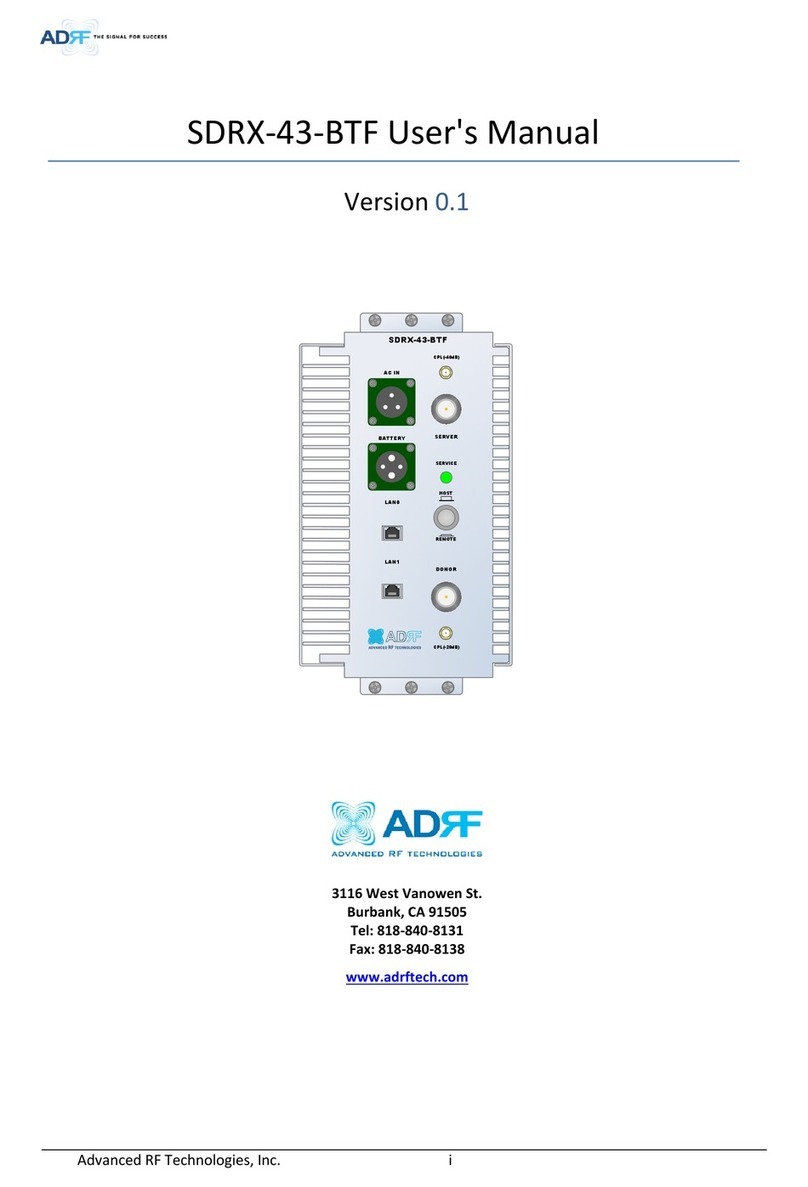
ADRF
ADRF SDRX-43-BTF User manual
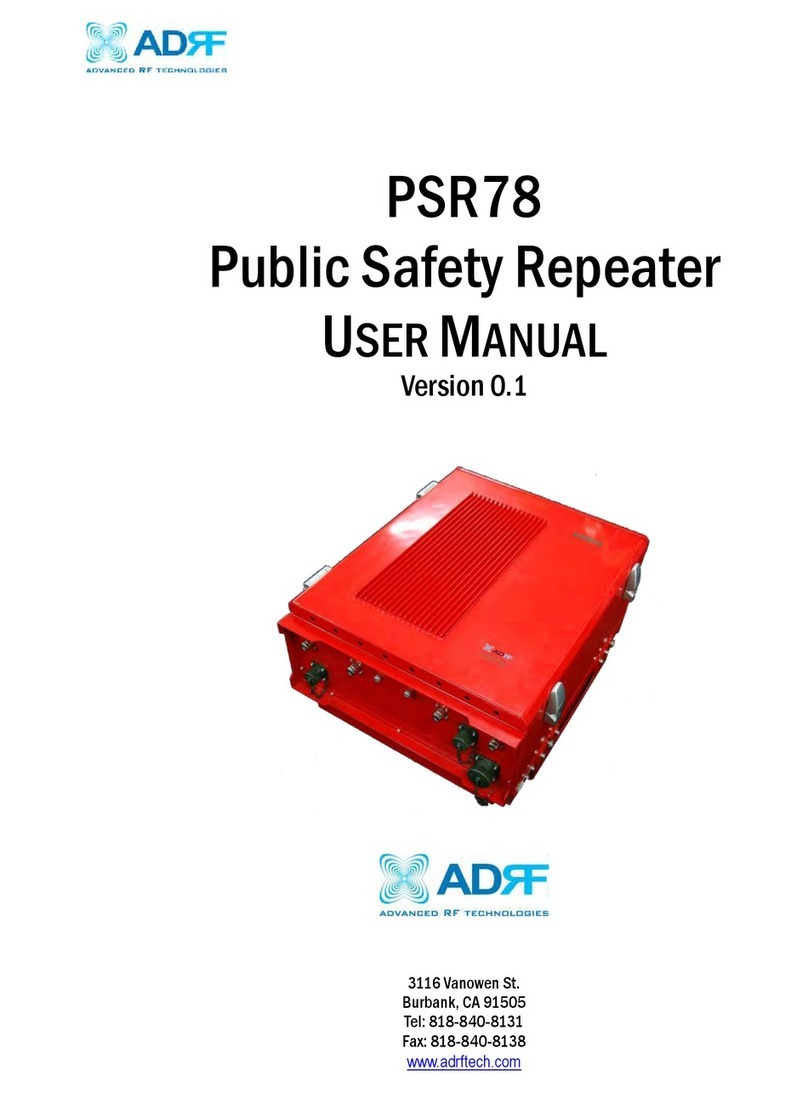
ADRF
ADRF PSR78 User manual
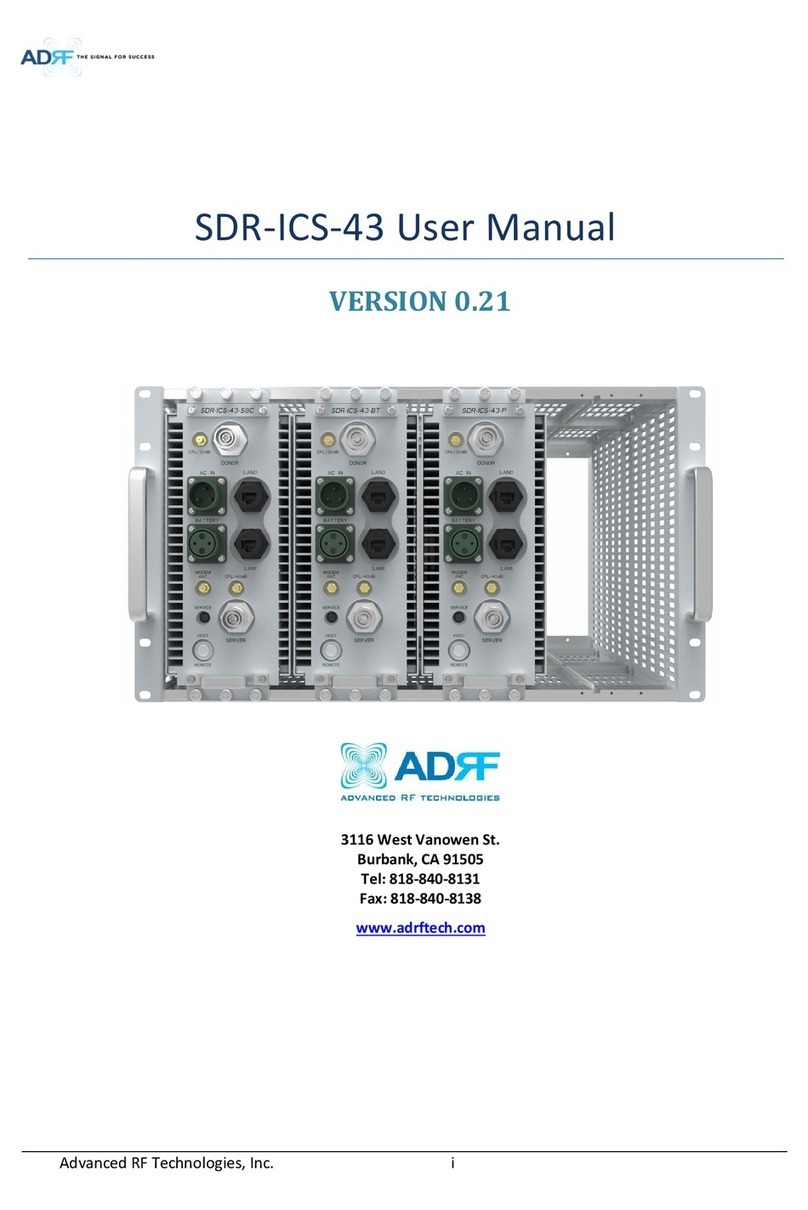
ADRF
ADRF SDR-ICS-43 User manual
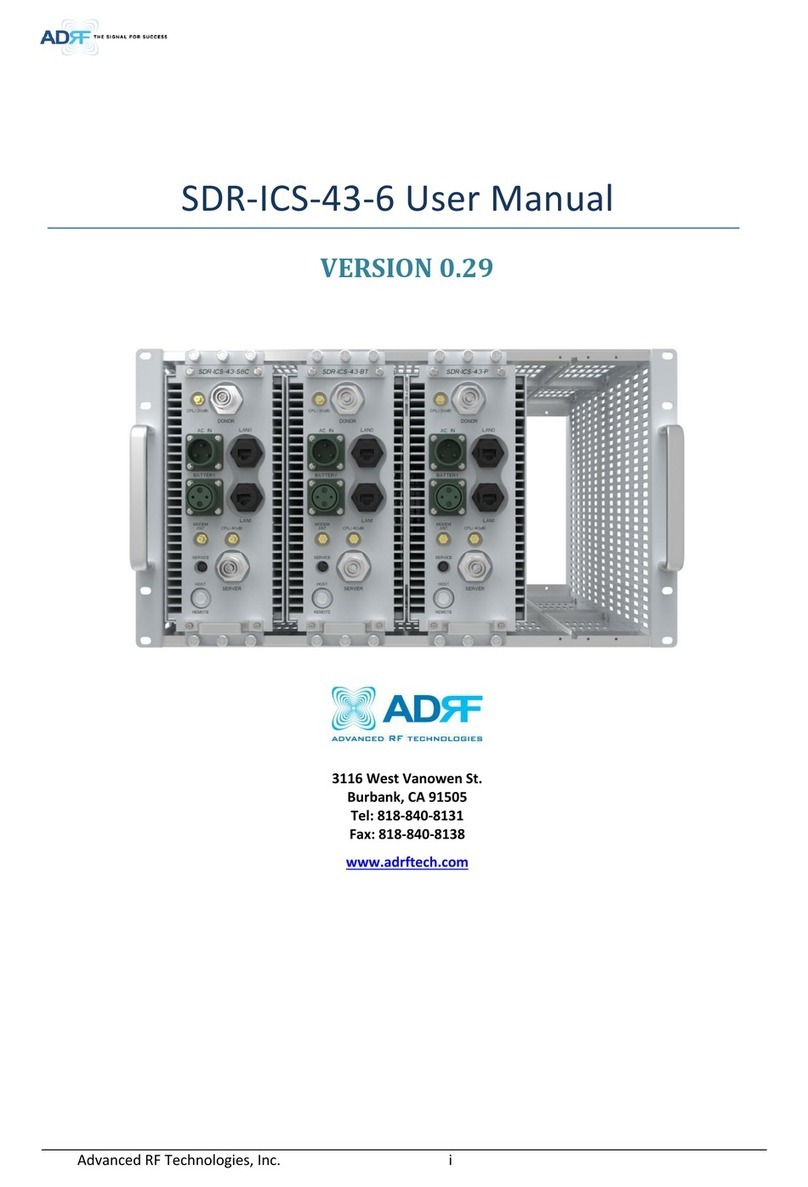
ADRF
ADRF SDR-ICS-43-6 User manual
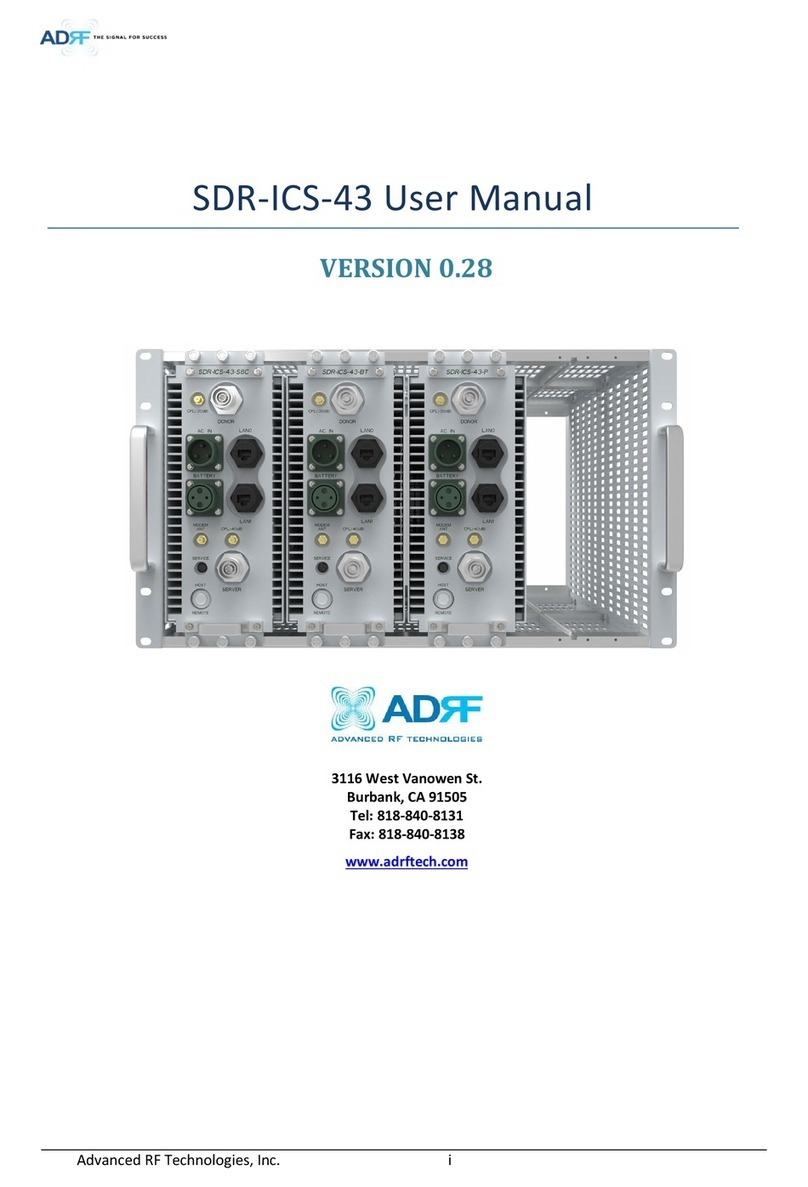
ADRF
ADRF SDR-ICS-43-W User manual
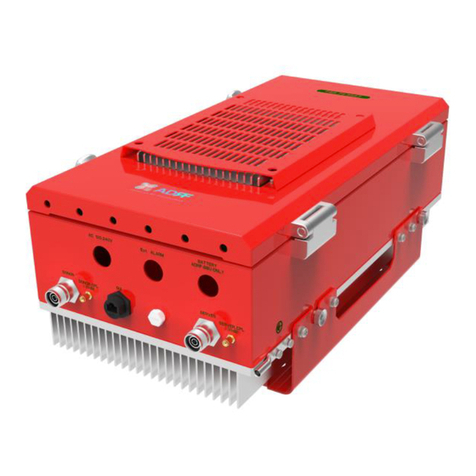
ADRF
ADRF FiRe-78-4 User manual
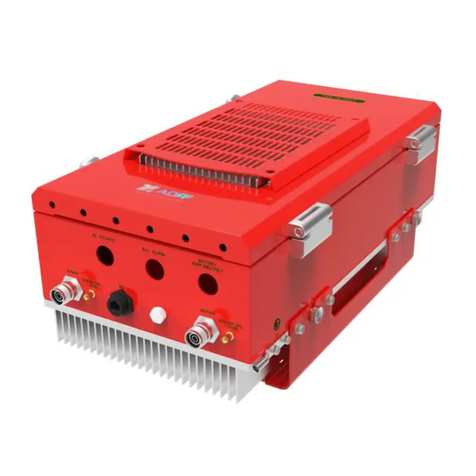
ADRF
ADRF PSR-VU-9537-UB User manual
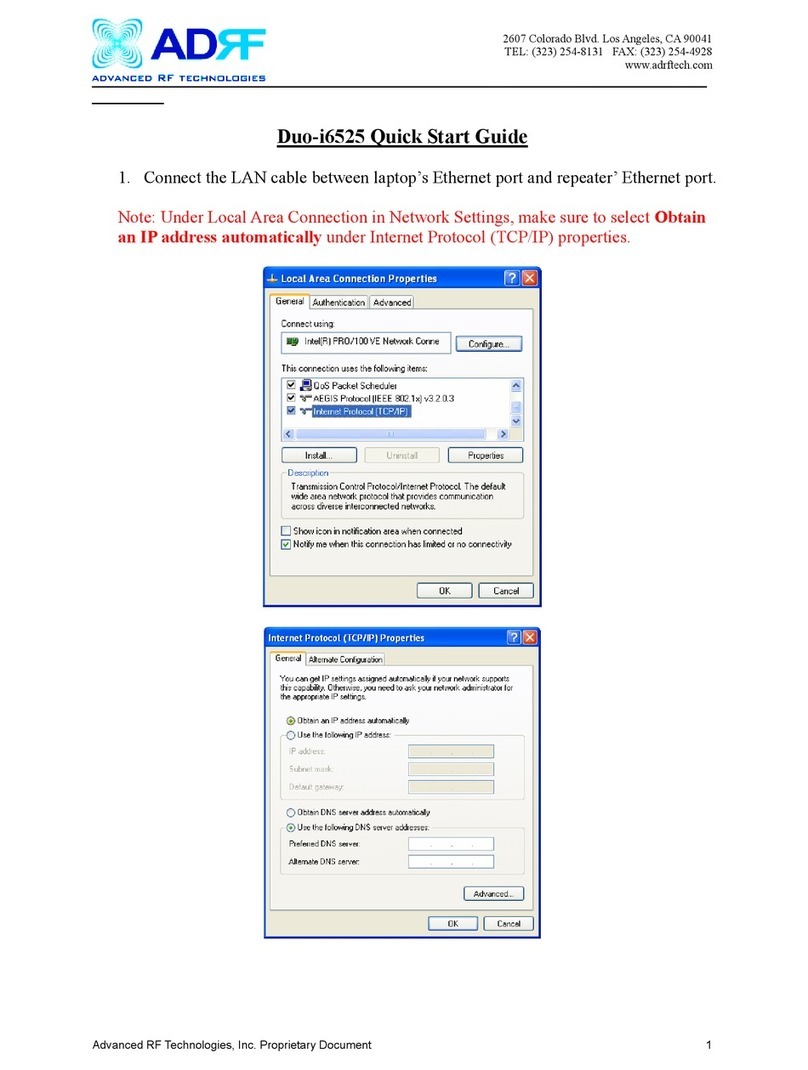
ADRF
ADRF Duo-i6525 User manual
